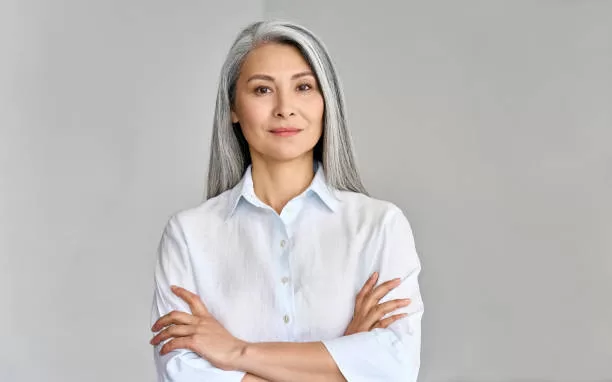Did you know that you can maintain a youthful face as you age? The aging process is a complex and multifaceted phenomenon that affects various aspects of our bodies, including our skin and overall appearance. It is a natural progression that develops over time under the influence of genetic, lifestyle, and external environmental factors.
However, one common observation is that our faces often appear to age more quickly than the rest of our bodies. This phenomenon can be attributed to several interconnected reasons, encompassing changes in skin structure, collagen loss, facial expressions, and cumulative environmental damage.
In this blog post, the Eastside Writers’ beauty professional will guide readers through the secret practices along with simple techniques to preserve a more youthful appearance of face skin as individuals age, thereby minimizing the presence of unpleasant wrinkles and prominent lines. We have explored many surgical and non-surgical techniques that may greatly benefit individuals seeking to regain their youthful appearance.

Why your face ages more than your body
- The structural nature of your facial skin
One of the primary factors contributing to the accelerated aging of the face is the intrinsic structural nature of facial skin. Unlike the skin on the rest of the body, facial skin is thinner and more delicate. It is composed of several layers, including the epidermis, dermis, and subcutaneous tissue, all of which play a crucial role in maintaining a youthful appearance. The epidermis acts as a protective barrier, while the dermis contains collagen and elastin, which provide elasticity and support to the skin. The subcutaneous tissue houses fat cells that help maintain facial volume and contour. As we age, these layers undergo various changes.
- Collagen
Collagen, a protein that gives skin its firmness and suppleness, diminishes with age. This reduction in collagen production is more pronounced in the facial skin than in other areas of the body. Collagen fibers become less dense and less organized, leading to sagging and the formation of wrinkles. Additionally, elastin fibers, responsible for skin’s elasticity, start to break down, causing a loss of skin resilience. These structural changes result in the loss of facial volume and the development of fine lines and wrinkles, which are often more noticeable on the face than on the body.
- Facial expressions
Facial expressions also play a significant role in the aging process of the face. Over a lifetime, we make countless facial expressions that involve the contraction of muscles around the eyes, mouth, and forehead. These repetitive movements, such as smiling, frowning, and squinting, can lead to the formation of dynamic wrinkles, also known as expression lines. As we age, the skin’s ability to bounce back after muscle contractions decreases due to the aforementioned decline in collagen and elastin. Consequently, expression lines become more prominent and may eventually become static wrinkles, even when the face is at rest.
Why do we like our faces to remain youthful?
The face is a focal point of human interaction and communication. This constant attention to the face makes any signs of aging more noticeable and often prompts individuals to seek interventions such as skincare products, cosmetic procedures, or surgery. The societal pressure to maintain a youthful appearance, coupled with the visibility of facial aging, can create a heightened awareness of the aging process in this particular area.
In contrast, the aging of the body is often less conspicuous and progresses at a slower rate due to several factors. Firstly, the skin on most areas of the body is thicker and less exposed to environmental factors than facial skin. This thickness provides better structural support and resilience, making it more resistant to the formation of wrinkles and sagging. Secondly, the body’s musculature differs from the facial muscles in terms of use and movement. While facial muscles are engaged in numerous daily expressions, the body’s muscles primarily serve functional purposes, such as mobility and support. This reduced muscular activity contributes to the slower development of lines and wrinkles on the body.
Additionally, lifestyle choices and skincare habits can play a role in the varying rates of aging between the face and body. People tend to be more diligent in protecting and caring for their facial skin, using sunscreen, moisturizers, and anti-aging products. On the other hand, the body may receive less attention in terms of skincare, leading to less cumulative damage. However, this can vary significantly from person to person, as some individuals may pay equal attention to their entire body.
The perception that the face ages more quickly than the body is rooted in a combination of structural, environmental, genetic, and behavioral factors. The unique composition of facial skin, including its thinner layers and high density of collagen and elastin fibers, makes it more susceptible to the effects of aging. Repetitive facial expressions, sun exposure, and other environmental stressors further accelerate this process.
On the contrary, the body’s thicker skin, lower muscular activity, and often more attentive skincare practices contribute to a slower rate of aging. Understanding these factors can help individuals make informed choices about skincare and aging gracefully while embracing the natural changes that occur over time.
What do we understand by face aging, and why does it happen?
Aging is a natural and inevitable process that affects every aspect of our bodies, including our faces. The aging of the face is a complex phenomenon that encompasses a multitude of biological, structural, genetic, and environmental factors. To fully comprehend why and how our faces age, it’s crucial to delve into the intricacies of facial aging.
Face aging, also known as facial aging, refers to the gradual and progressive changes in the appearance of the face as an individual grows older. These changes manifest in various ways. including the development of wrinkles, fine lines, sagging skin, loss of facial volume, and alterations in skin texture and tone. While aging is a universal experience, the rate and extent of facial aging can vary significantly from person to person due to a combination of genetic and environmental factors.
The key factors that contribute to these visible changes in your face as you age
Structural Changes:
The skin on the face is structurally different from the skin on the rest of the body. It is composed of several layers, including the epidermis (outermost layer), dermis (middle layer), and subcutaneous tissue (the deepest layer). These layers play a vital role in maintaining the youthful appearance of the face.
- Epidermis: The epidermis acts as a protective barrier, preventing moisture loss and shielding against environmental damage. With age, the epidermis becomes thinner, which can lead to increased susceptibility to dryness and damage.
- Dermis: The dermis contains collagen and elastin fibers that provide support and elasticity to the skin. Collagen is a protein responsible for the skin’s firmness and suppleness, while elastin allows the skin to bounce back after stretching. As people age, collagen production decreases, and existing collagen fibers become less organized and more fragile. Elastin fibers also break down, resulting in reduced skin elasticity. These structural changes contribute to the formation of wrinkles, fine lines, and sagging skin.
- Subcutaneous Tissue: The subcutaneous tissue contains fat cells that help maintain facial volume and contour. As individuals age, these fat cells gradually diminish in size and number, leading to a loss of facial fullness and a more hollow appearance.

Genetics:
Genetic factors play a significant role in determining how an individual’s face ages. Some people are genetically predisposed to age more gracefully, with fewer visible signs of aging, while others may experience more pronounced facial aging at an earlier age. Genes can influence various aspects of facial aging, including skin texture, collagen production, and the tendency to develop specific facial features such as wrinkles or sagging skin.
Hormonal Changes:
Hormonal fluctuations, particularly in women, can contribute to facial aging. The onset of menopause is a notable hormonal transition that can lead to changes in skin thickness, moisture retention, and collagen production. These hormonal shifts can exacerbate the appearance of wrinkles and dryness.
Sun Exposure:
One of the primary external factors responsible for facial aging is prolonged and unprotected sun exposure. Ultraviolet (UV) radiation from the sun can cause significant damage to the skin. Over time, this damage can result in a process known as photoaging, characterized by the breakdown of collagen and elastin fibers. UV radiation can also lead to the formation of sunspots, uneven skin tone, and deep wrinkles. Given that the face is often the most exposed part of the body to the sun, it is particularly vulnerable to these effects, making it prone to premature aging.
Lifestyle Choices:
Various lifestyle factors can influence the rate of facial aging. Smoking, for instance, is known to accelerate skin aging by constricting blood vessels, reducing blood flow, and depleting the skin of essential nutrients. Additionally, poor dietary choices, excessive alcohol consumption, and a sedentary lifestyle can contribute to accelerated aging.
Facial Expressions:
The constant use of facial muscles for expressions such as smiling, frowning, squinting, and raising eyebrows can lead to the formation of dynamic wrinkles, also known as expression lines. These lines occur as a result of repetitive muscle contractions. Over time, these dynamic wrinkles can become more prominent and may eventually become static wrinkles, visible even when the face is at rest.
Environmental Factors:
Beyond sun exposure, environmental factors such as pollution and harsh weather conditions can impact facial aging. Air pollution can lead to the production of free radicals, which can accelerate the breakdown of collagen and elastin in the skin. Additionally, harsh winds, cold temperatures, and low humidity levels can contribute to dryness and skin damage.
Skincare Habits:
Personal skincare habits and routines play a crucial role in the aging process. Regular skin care practices, including cleansing, moisturizing, and sun protection, can help mitigate some of the effects of aging. Conversely, neglecting proper skincare can accelerate the aging process and lead to premature skin damage.
Gravity:
Gravity exerts a constant force on the face over time, contributing to the sagging of facial tissues. As collagen and elastin fibers weaken with age, the skin’s ability to resist the pull of gravity diminishes, leading to the characteristic drooping of facial features.
Social and Psychological Factors:
Finally, social and psychological factors can influence how individuals perceive and experience facial aging. Societal standards of beauty and the desire to maintain a youthful appearance can lead people to seek cosmetic interventions and skincare products to address aging concerns.
Why your face ages more than your body ages
The aging process is a complex and multifaceted phenomenon that affects various aspects of our bodies, including our skin and overall appearance. It is a natural progression that develops over time under the influence of genetic, lifestyle, and external environmental factors. One common observation is that our faces often appear to age more quickly than the rest of our bodies. This phenomenon can be attributed to several interconnected reasons, encompassing changes in skin structure, collagen loss, facial expressions, and cumulative environmental damage.
One of the primary factors contributing to the accelerated aging of the face is the intrinsic structural nature of facial skin. Unlike the skin on the rest of the body, facial skin is thinner and more delicate. It is composed of several layers, including the epidermis, dermis, and subcutaneous tissue, all of which play a crucial role in maintaining a youthful appearance. The epidermis acts as a protective barrier, while the dermis contains collagen and elastin, which provide elasticity and support to the skin. The subcutaneous tissue houses fat cells that help maintain facial volume and contour. As we age, these layers undergo various changes.
Collagen, a protein that gives skin its firmness and suppleness, diminishes with age. This reduction in collagen production is more pronounced in the facial skin than in other areas of the body. Collagen fibers become less dense and less organized, leading to sagging and the formation of wrinkles. Additionally, elastin fibers, responsible for skin’s elasticity, start to break down, causing a loss of skin resilience. These structural changes result in the loss of facial volume and the development of fine lines and wrinkles, which are often more noticeable on the face than on the body.
Furthermore, facial expressions play a significant role in the aging process of the face. Over a lifetime, we make countless facial expressions that involve the contraction of muscles around the eyes, mouth, and forehead. These repetitive movements, such as smiling, frowning, and squinting, can lead to the formation of dynamic wrinkles, also known as expression lines. As we age, the skin’s ability to bounce back after muscle contractions decreases due to the aforementioned decline in collagen and elastin. Consequently, expression lines become more prominent and may eventually become static wrinkles, even when the face is at rest.
Another critical aspect to consider is the cumulative impact of environmental factors on facial aging. The face is more exposed to the external environment than most other parts of the body, making it susceptible to various environmental stressors. Ultraviolet (UV) radiation from the sun is one of the primary culprits in accelerating facial aging. Prolonged sun exposure without adequate protection can lead to photoaging, a process characterized by the breakdown of collagen and the development of sunspots, uneven skin tone, and deep wrinkles. This photoaging is particularly pronounced on the face, where the skin is consistently exposed to the sun’s harmful rays. In addition to UV radiation, pollution, smoking, and poor skincare practices can also contribute to premature facial aging.
Beyond these structural and environmental factors, there are genetic and hormonal elements at play. Genetics can dictate how quickly an individual’s skin ages and how prone they are to certain skin conditions. Hormonal changes, especially during menopause in women, can lead to a decrease in skin thickness and moisture retention, exacerbating the appearance of facial wrinkles and dryness.
Moreover, the face is a focal point of human interaction and communication. This constant attention to the face makes any signs of aging more noticeable and often prompts individuals to seek interventions such as skincare products, cosmetic procedures, or surgery. The societal pressure to maintain a youthful appearance, coupled with the visibility of facial aging, can create a heightened awareness of the aging process in this particular area.
In contrast, the aging of the body is often less conspicuous and progresses at a slower rate due to several factors. Firstly, the skin on most areas of the body is thicker and less exposed to environmental factors than facial skin. This thickness provides better structural support and resilience, making it more resistant to the formation of wrinkles and sagging. Secondly, the body’s musculature differs from the facial muscles in terms of use and movement. While facial muscles are engaged in numerous daily expressions, the body’s muscles primarily serve functional purposes, such as mobility and support. This reduced muscular activity contributes to the slower development of lines and wrinkles on the body.
Additionally, lifestyle choices and skincare habits can play a role in the varying rates of aging between the face and body. People tend to be more diligent in protecting and caring for their facial skin, using sunscreen, moisturizers, and anti-aging products. On the other hand, the body may receive less attention in terms of skincare, leading to less cumulative damage. However, this can vary significantly from person to person, as some individuals may pay equal attention to their entire body.

What can I do about my aging face? Is there any therapy or preventive measures?
As we age, the changes in our faces can be a source of concern for many individuals. The good news is that there are numerous therapies and preventive measures available to address and mitigate the signs of facial aging. These strategies encompass a broad spectrum, ranging from skincare routines and lifestyle adjustments to non-invasive treatments and surgical procedures, all tailored to suit individual preferences and goals.
1. Skincare and Preventive Measures:
a. Sun Protection: One of the most effective ways to prevent and slow down facial aging is by diligently protecting your skin from the sun’s harmful ultraviolet (UV) radiation. Always wear broad-spectrum sunscreen with an SPF of at least 30, even on cloudy days. Additionally, wear protective clothing like wide-brimmed hats and sunglasses to shield your face from UV rays.
b. Hydration: Keeping your skin adequately moisturized is essential for maintaining its youthful appearance. Use a good-quality moisturizer to lock in moisture, especially if you have dry skin. Consider products containing hyaluronic acid, a natural substance that helps retain skin moisture.
c. Gentle Cleansing: Avoid harsh or abrasive cleansers that can strip your skin of its natural oils. Opt for a gentle, pH-balanced cleanser that effectively removes impurities without causing irritation.
d. Antioxidants: Incorporate antioxidant-rich products into your skincare routine. Antioxidants help protect your skin from free radical damage, which can accelerate aging. Vitamin C serums, for example, are known for their antioxidant properties.
e. Retinoids: Retinoids, such as retinol or prescription-strength tretinoin, are clinically proven to reduce fine lines, improve skin texture, and promote collagen production. Start with a lower-strength product to minimize potential irritation and gradually increase as your skin tolerates it.
f. Topical Moisturizing Ingredients: Look for products that contain ingredients like peptides, ceramides, and niacinamide, as they can help improve skin texture and maintain its barrier function.
g. Lifestyle Choices: Making healthy lifestyle choices can significantly impact the aging process. These include:
- Balanced Diet: Consume a diet rich in fruits, vegetables, lean proteins, and healthy fats. Omega-3 fatty acids, found in fish and flaxseed, can benefit your skin’s health.
- Stay Hydrated: Drinking plenty of water helps maintain skin hydration from within.
- Avoid smoking: Smoking is a major contributor to premature skin aging. Quitting smoking can improve skin quality and overall health.
- Moderate Alcohol Consumption: Excessive alcohol intake can dehydrate the skin and contribute to the development of wrinkles. Limit your alcohol consumption to support skin health.
- Regular Exercise: Exercise improves circulation and can promote a healthy complexion.
2. Non-Invasive Cosmetic Procedures:
Non-invasive or minimally invasive cosmetic procedures offer effective options for rejuvenating the face without the need for surgery. These treatments are typically less expensive and require less downtime compared to surgical interventions. Some popular non-invasive options include:
a. Botox and Dysport: These injectables contain botulinum toxin, which temporarily relaxes facial muscles responsible for wrinkles, particularly in the forehead and around the eyes. They are effective for treating dynamic wrinkles, such as crow’s feet and forehead lines.
b. Dermal Fillers: Hyaluronic acid-based dermal fillers like Juvederm and Restylane can restore lost facial volume, smooth out wrinkles, and enhance contours. They are commonly used to plump lips, fill in nasolabial folds, and rejuvenate the mid-face area.
c. Chemical Peels: Chemical peels involve the application of a chemical solution to the skin to exfoliate and remove damaged outer layers. They can improve skin texture, reduce the appearance of fine lines, and promote a more youthful complexion.
d. Laser and IPL Therapy: Laser and intense pulsed light (IPL) treatments can target various skin concerns, including pigmentation irregularities, broken blood vessels, and skin texture issues. Fractional laser treatments stimulate collagen production and can help reduce wrinkles.
e. Microdermabrasion: This non-invasive exfoliation technique uses a machine to remove dead skin cells, improving skin texture and reducing the appearance of fine lines and dullness.
3. Surgical Interventions:
For individuals seeking more significant and long-lasting results, surgical procedures can address advanced signs of facial aging. These procedures should be considered after thorough consultation with a qualified plastic surgeon or dermatologist. Some surgical options include:
a. Facelift: A facelift, or rhytidectomy, is a surgical procedure that lifts and tightens the facial tissues to restore a more youthful appearance. It can address sagging skin, deep wrinkles, and loss of facial definition.
b. Brow Lift: Also known as a forehead lift, this procedure elevates the brow and smooths forehead wrinkles. It can provide a more youthful and refreshed appearance.
c. Eyelid Surgery (Blepharoplasty): Eyelid surgery can rejuvenate the eyes by removing excess skin, fat, and muscle from the upper and lower eyelids. It can address drooping eyelids and under-eye bags.
d. Neck Lift: A neck lift focuses on tightening loose skin and muscles in the neck area. It can help eliminate the appearance of sagging jowls and neckbands.
e. Fat Grafting: Fat grafting, also known as fat transfer, involves the transfer of a patient’s own fat from one area of the body to restore volume in the face. This procedure can address hollowed cheeks and thin lips.
4. Combination Approaches:
Many individuals opt for a combination of treatments to achieve comprehensive facial rejuvenation. A personalized plan that combines non-invasive procedures, minimally invasive techniques, and surgical interventions can yield optimal results while minimizing downtime and recovery.
Before pursuing any cosmetic procedure or treatment, it’s crucial to consult with a board-certified dermatologist or plastic surgeon who can assess your individual needs and recommend the most suitable options. Additionally, realistic expectations are vital; while these treatments can enhance your appearance and slow the aging process, they cannot halt it entirely.
Complementing these interventions with a healthy lifestyle, a regular skincare routine, and sun protection is essential for maintaining a youthful complexion over the long term. Ultimately, the path to addressing facial aging should be based on your unique goals, concerns, and comfort level with various treatment options.
Nonsurgical alternatives that are available to combat face aging
Nonsurgical alternatives for treating facial aging have become increasingly popular due to their effectiveness, minimal downtime, and reduced risks compared to surgical procedures. These nonsurgical options encompass a range of treatments designed to address various signs of aging, such as wrinkles, fine lines, sagging skin, and loss of facial volume. Here are some of the most commonly used nonsurgical treatments for facial aging:
- Botulinum Toxin (Botox/Dysport): Botulinum toxin injections are a widely sought-after nonsurgical option for addressing dynamic wrinkles, which are caused by repeated muscle contractions. Botox and Dysport temporarily relax the facial muscles responsible for lines and wrinkles, such as crow’s feet and frown lines between the eyebrows. The result is smoother, more youthful-looking skin. Treatment typically takes just a few minutes, and results can last for several months.
- Dermal Fillers: Dermal fillers are injectable products designed to restore lost facial volume, soften wrinkles, and enhance facial contours. The most commonly used dermal fillers contain hyaluronic acid, a substance naturally found in the skin. Popular brands include Juvederm, Restylane, and Belotero. These fillers can be used to plump lips, smooth nasolabial folds (lines that run from the nose to the mouth), and address sagging in the mid-face area. Results are immediate, and the effects can last from six months to two years, depending on the product used.
- Chemical Peels: Chemical peels are nonsurgical treatments that use a chemical solution to exfoliate the top layer of skin. This process removes damaged skin cells, improving skin texture, reducing the appearance of fine lines, and promoting a more youthful complexion. There are different types of chemical peels, ranging from superficial peels (mild) to deep peels (more intense). Recovery time varies depending on the depth of the peel.
- Microdermabrasion: Microdermabrasion is a minimally invasive exfoliation technique that uses a machine to gently remove the top layer of dead skin cells. This treatment can improve skin texture, reduce fine lines, and enhance the overall appearance of the skin. It is a quick and painless procedure with no downtime, making it an excellent option for those looking for a subtle rejuvenation.
- Laser and IPL (Intense Pulsed Light) Therapy: Laser and IPL treatments can address a wide range of facial aging concerns, including pigmentation irregularities, broken blood vessels, and uneven skin texture. Fractional laser treatments stimulate collagen production, helping to reduce the appearance of wrinkles. These treatments are non-invasive and often require minimal downtime.
- Platelet-Rich Plasma (PRP) Therapy: PRP therapy involves drawing a small amount of the patient’s blood, processing it to isolate the platelet-rich plasma, and then injecting it into the face. PRP contains growth factors that stimulate collagen production and tissue regeneration, improving skin texture and tone. It can be used to treat fine lines, wrinkles, and acne scars. PRP is sometimes combined with other treatments, such as microneedling, to enhance results.
- Thread Lifts: Thread lifts are nonsurgical procedures that use dissolvable threads to lift and tighten sagging skin. These threads are inserted under the skin, and once in place, they provide support to the facial tissues. Thread lifts are often used to address sagging jowls, mid-face sagging, and neck laxity. The results are immediate, and they continue to improve over time as collagen production is stimulated.
- Microfocused Ultrasound (Ultherapy): Ultherapy is a nonsurgical procedure that uses focused ultrasound energy to stimulate collagen production deep within the skin. It is commonly used to lift and tighten the skin on the face and neck. While the results may take a few months to fully develop, the treatment provides a natural-looking lift without surgery.
- Neurotoxin and Dermal Filler Combinations: Some practitioners combine neurotoxins (like Botox) with dermal fillers in a single treatment session to address multiple aspects of facial aging. This approach can provide both muscle relaxation and volume restoration, yielding comprehensive facial rejuvenation.
- Topical Skincare Products: High-quality skincare products containing active ingredients such as retinoids, antioxidants (e.g., vitamin C), peptides, and growth factors can help maintain and improve the appearance of the skin. While these products do not deliver immediate results like injectables or lasers, they can be an integral part of a long-term skincare regimen.
- Home Devices: Advancements in technology have led to the development of various home devices designed to improve skin texture and reduce the appearance of fine lines and wrinkles. These devices typically use technologies such as radiofrequency or microcurrent stimulation. While results may be more gradual compared to professional treatments, they can be convenient for ongoing maintenance.

It’s important to note that the choice of nonsurgical treatments should be based on individual goals, concerns, and the advice of a qualified medical professional. A consultation with a board-certified dermatologist or plastic surgeon is essential to determine the most suitable treatments and customize a plan tailored to your specific needs. Nonsurgical interventions can provide noticeable and satisfying results, often with minimal discomfort and downtime, making them an attractive option for those seeking to address the signs of facial aging without undergoing surgery.
Conclusion
The perception that the face ages more quickly than the body is rooted in a combination of structural, environmental, genetic, and behavioral factors. The unique composition of facial skin, including its thinner layers and high density of collagen and elastin fibers, makes it more susceptible to the effects of aging.
A combination of intrinsic (such as genetics and hormones) and extrinsic (such as sun exposure and lifestyle choices) factors affect facial aging, which is a complex process. The unique structural characteristics of facial skin, including its thinness and the presence of collagen and elastin fibers, make it particularly susceptible to the visible signs of aging.
While facial aging is a natural part of life, understanding the underlying mechanisms and adopting a proactive approach to skincare and healthy living can help individuals age gracefully and maintain their confidence and self-esteem as they journey through the inevitable process of getting older.
Disclaimer:
The author’s views are his or her own. The facts and opinions in the article have been taken from various articles and commentaries available in the online media, and Eastside Writers does not take any responsibility or obligation for them.
Note: Contact our Writers at www.eastsidewriters.com for writing Blogs/Articles on any niche. We have experts in various domains from Technology to Finance and from Spirituality to Lifestyle and Entertainment.







Pingback: Tips for Professional Women to Stay Radiant and Fresh in the Office - Eastside Writers